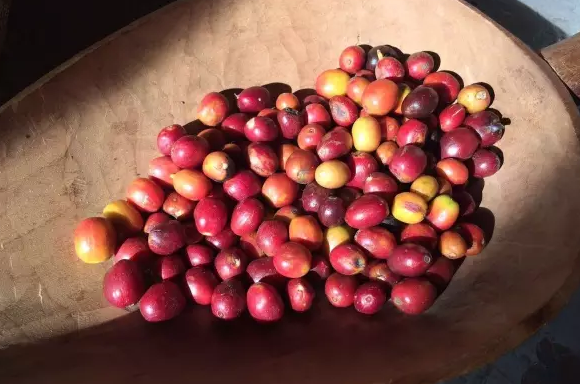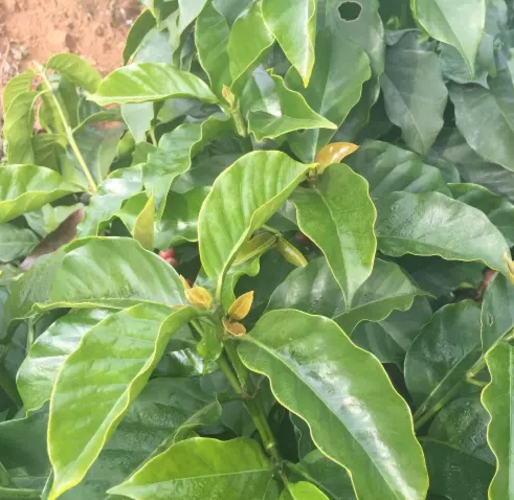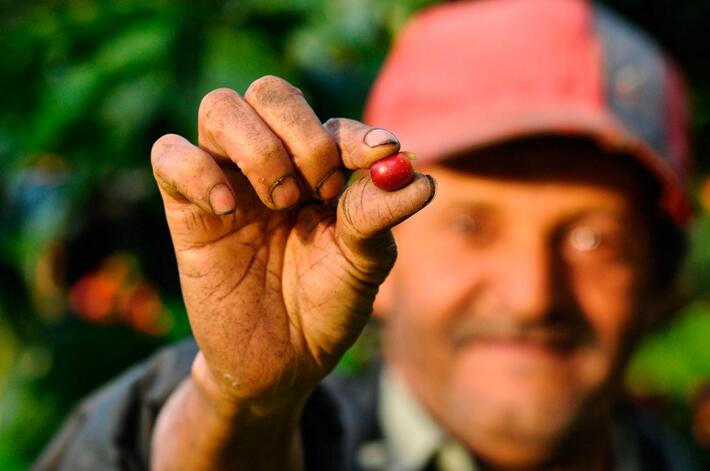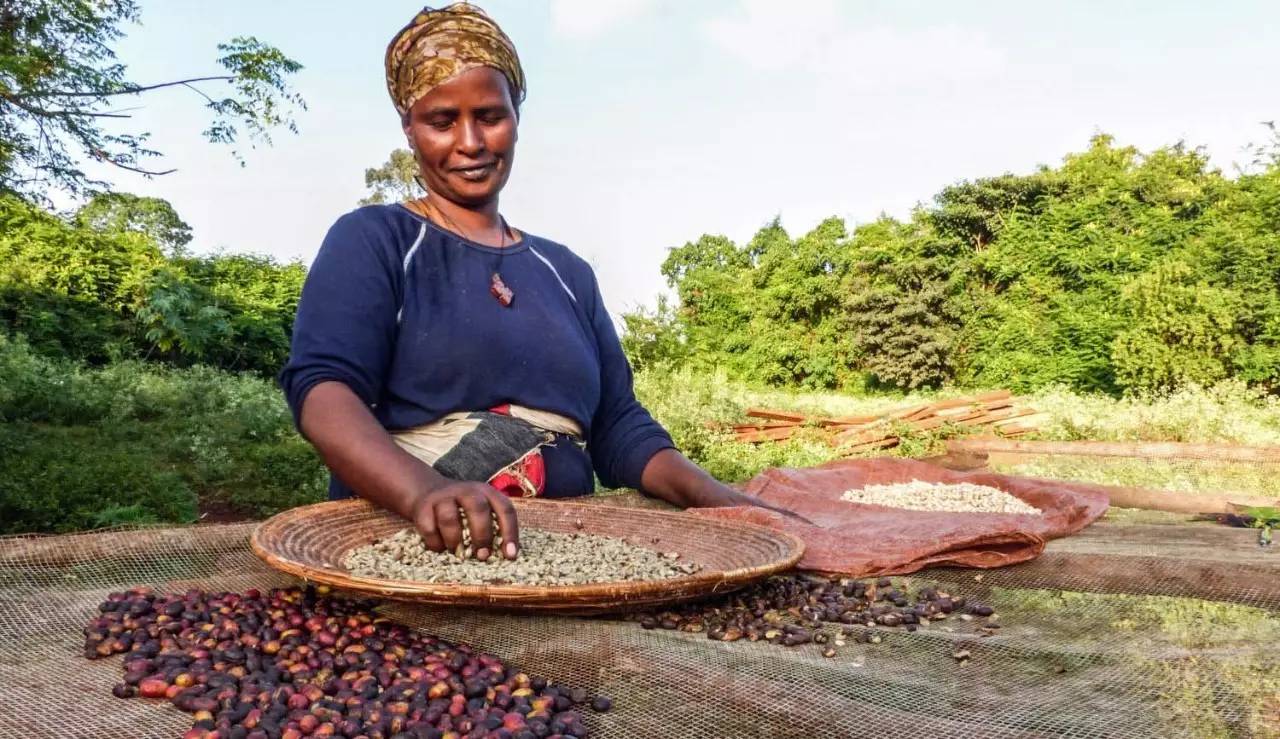Measurement data record of Sanani Mocha Cup during the Transformation process of Mocha Coffee in Yemen
Yemeni mocha coffee-unique flavor some people say, in the coffee, Blue Mountain can be king, mocha can be called queen. Mocha is like love, sweet in bitterness and bitter in bitterness, just like the ups and downs of love. It's about something called happiness.

Yemeni mocha is one of the oldest coffee in the world, but until recently, Yemeni mocha has come to be regarded as one of the best and most delicious coffee in the world. Mocha coffee, which has a long history, is synonymous with coffee. Its unique aroma and sour taste have deeply attracted many coffee lovers. If you are a pure naturalist, the Yemeni mocha can satisfy your desire to drink coffee that has been completely natural.
Mocha beans are smaller, rounder and light green than most coffee beans, which makes mocha beans look more like peas. Mocha beans are similar in shape to Ethiopia's Harald beans, with small particles, high acidity and a strange and indescribable spicy flavor. Taste carefully, but also can distinguish a little chocolate flavor, so the attempt to add chocolate to coffee is a very natural process of development. Mocha coffee is characterized by its fruity flavor, with obvious wine, spicy and nutty flavors. Some people say that Yemeni mocha tastes like blueberries, while others say it is a "wild flavor" peculiar to the Red Sea.
I. the history of Yemeni coffee
(1) the origin of mocha coffee
In Yemen, the origin of coffee is very wide, and these coffees have their own characteristics from quality to taste, but they are collectively called mocha coffee because they have historically been shipped and exported from the Yemeni port of Mocha to markets around the world. The port of Mocha is located on the coast of the Red Sea north of the Mande Strait, about 100 kilometers by land from Aden. In addition, coffee grown in countries such as Ethiopia in the northeast corner of Africa is of the same origin as Yemeni coffee, so it is also known as mocha coffee.
Yemen is the first country in the world to grow coffee on a large scale and has a long history. As early as the beginning of the 6th century, when coffee spread from the Horn of Africa to Yemen, Yemenis began to grow coffee as a cash crop.
The international trade in mocha coffee began in the early 16th century, when the Turkish royal family began to drink mocha coffee from Yemen. There are also records of mocha coffee in the archives of Portuguese merchant ships in the 17th century. After a long voyage, Portuguese sailors came to the port of Mocha on the coast of the Red Sea to resupply. The leaders of the local tribe entertained them with a black drink that the Portuguese had never seen before. the drink was unique and exhilarating and popular with sailors.
Coffee trading companies were first established by the Dutch in the early 17th century, and coffee began to be exported to Europe from the port of Mocha, which was very popular in Western European markets from Amsterdam to Paris. In the next two hundred years or so, Yemeni mocha coffee almost monopolized the entire European market. With the development of coffee trade, the port of Mocha has developed rapidly from an unknown fishing village to a new port city.
But since the 19th century, coffee seeds brought back by European sailors have been successfully propagated, and countries such as the Netherlands, France and Portugal have begun to grow coffee in their colonies, and gradually far exceed Yemen in quantity. The big European countries control and monopolize the coffee trade, resulting in a shrinking coffee export industry in the port of Mocha. Nevertheless, at the beginning of the 20th century, Yemeni coffee exports reached about 20,000 tons a year. Today, the original site of the port of Mocha has long been abandoned, and the export of Yemeni mocha coffee is mainly in the northern port of Hodeida.

(2) the characteristics of mocha coffee
Yemenis have had the habit of drinking coffee since ancient times, and the coffee culture here is very different from that of other parts of the world. In Yemen, there are many middlemen engaged in the acquisition and storage of coffee, the newly purchased coffee is in no hurry to sell every year, and coffee farmers also hoard coffee at home as a means of saving. the ones that really enter the market are often old beans that have been in stock for several years. Due to the dry climate and lack of rain in Yemen, the water content of these coffee beans is very low, which gives Yemeni coffee a very unique taste.
In the coastal plain of the Red Sea in western Yemen, the climate and soil and water conditions are not suitable for growing coffee, and coffee is mainly produced in the western mountains. Mocha coffee grows in the mountains at an altitude of 3000 meters, where the geographical environment is unique, the mountain is rugged, the air is thin, the light is strong, and the water comes from rainfall and mountain springs, which make mocha coffee special aroma and taste. The local farmers carved out fertile terraces on the hillside. To this day, coffee is still grown in the same way in these areas as it was three or four hundred years ago, relying entirely on artificial labor, never using any chemical fertilizers or pesticides, and relying on sunshine, Rain Water and unique soil to grow pure natural Yemeni coffee. In fact, coffee grown in Haiti, Ethiopia and the West Indies belongs to the same ancestry as Yemeni coffee, and many of them are known as mocha coffee. However, for a variety of reasons, their taste and aroma are very different from those of mocha coffee produced in Yemen.
Yemeni coffee is also picked and processed entirely by hand. The preliminary processing of coffee beans is made by drying and drying naturally in the sun. This method is the most primitive and simple, without any machinery or cleaning, so sometimes there are a small amount of sand and pebbles in Yemeni coffee beans. At present, only Brazil, Haiti and a few parts of India still use drying method to treat coffee beans. The coffee roasting process is also done entirely by hand, and the heat depends entirely on experience and feeling. Every process from planting, picking to roasting is done in the oldest way, and although the roasted beans are of different colors, it is this aroma mixed with rugged and wild flavors that makes the unique Yemeni mocha coffee. No wonder some people call Mocha "the diamond in the crown of Asian coffee".
Yemeni coffee has different names according to its specific origin, and there are 13 main kinds of coffee. Although the taste and flavor are slightly different, it is still collectively called mocha. Among them, the most famous varieties, such as Sanani, Mattari and Harazi, are mainly distributed in the mountains around the capital Sana'an and the high-altitude mountains between Sana'an and Hodeida province. Yemeni mocha coffee has small fruit, high density, high acidity and unique aroma. Compared with other famous coffee varieties, it has a strong sour taste, as well as a mixture of malt, nuts, wine, chocolate and other spices.
II. Current situation of coffee industry in Yemen
(1) the total output has continued to decline in recent years
Since 2001, Yemeni coffee production has declined year by year due to various reasons. The annual output has dropped from 11906 tons in 2001 to 11608 tons in 2003, 11590 tons in 2004, to about 11000 tons in 2008. In recent years, despite the rising prices in the international coffee market, the coffee industry in Yemen has not boomed, but has shrunk sharply. The reason for the decrease in coffee production is mainly due to two aspects.
First, water scarcity and soil degradation. The shortage of water resources has become a serious constraint to the economic and social development of Yemen. Coffee planting water mainly depends on Rain Water and mountain spring water, lack of irrigation facilities, water efficiency is not high, greatly affected by climate uncertainty. Soil degradation and soil erosion are serious, and the fertility and productivity of the land are weakening.
Second, farmers gave up growing coffee and planted Carter instead. The growth cycle of coffee is long, the cost is high, and the management is difficult, while Carter is easy to grow, the growing period is short, and the demand is strong, so many farmers have changed the original coffee land to planting Carter, while the planting area of coffee has decreased. Carter's planting area is increasing year by year. The shrinking acreage of coffee and the continuous decline in production, coupled with the shortage of water resources and diseases and insect pests in Yemen, have made coffee cultivation even worse.

(2) low output of high-quality mocha coffee and lack of quality standards
Although the annual output of Yemeni mocha coffee is more than 10,000 tons, only about 15% of the coffee can meet the import standards of developed countries.
The cultivation of coffee in Yemen has a long history, but the coffee industry has been in an unorganized and extensive stage of development. Due to the scattered planting, it is basically a decentralized operation in a workshop, which leads to a great difference in the quality of coffee. There are no unified standards and specifications for the picking, drying and stir-frying of coffee beans. Hand-processed coffee is easy to change color, high damage rate, and different moisture content. Farmers' techniques for growing and processing coffee are handed down from generation to generation, which is not only inefficient, but also unscientific, which lags far behind the development trend of the international coffee market.
At the same time, there is no identification standard and quality control system for coffee in Yemen, and the quality of coffee is not tested and classified in accordance with international practice. The lack of effective guarantee of coffee quality is not conducive to breaking into the markets of developed countries, and some unscrupulous businessmen even swap coffee from other countries and regions and pass them off as Yemeni mocha coffee after processing. There is still a long way to go to improve the quality and market competitiveness of Yemeni coffee.
(3) Coffee export shrinks
Coffee used to be at the forefront of Yemen's exports, but with the large-scale oil development and the development of fisheries, the status of coffee as a major export commodity has declined year by year. It has dropped from the top five ten years ago to the 23 or fourth place in recent years.
Since 2001, Yemeni coffee production has declined for four consecutive years, and coffee exports have been hit hard with the decline in coffee production.
In 2005, the Yemeni Ministry of Agriculture and Irrigation proposed a plan to plant 1 million coffee trees in one year. With the strong support of the Yemeni Ministry of Agriculture and Irrigation, the government has increased investment in the coffee planting industry, actively encouraged farmers to plant coffee trees, and adopted a series of promotion measures, including the construction of water conservancy facilities and the promotion of planting technology, etc., hoping to develop coffee production and strive for export to earn foreign exchange.
Under these measures, coffee production and export have been restored and developed to a certain extent in recent years. Table 1 shows the statistics on the export of raw coffee beans. It can be seen from the table that the annual decline of raw coffee bean exports has been curbed since 2006, and began to pick up, and the export volume in 2007 has been close to the level of 2003. However, on the whole, the proportion of coffee in the composition of Yemeni export commodities is still low and does not give full play to the advantages and potential of its coffee brand.

(4) exports are mainly raw materials and semi-finished products, and the export structure is unreasonable
More than 90% of Yemeni coffee exports are coffee beans, and refined coffee powder accounts for no more than 10%. The coffee exported from Yemen is mainly unprocessed and primary processed products, and the deep processing capacity is not strong, while the value of deep processing and its added value are much larger than the initial processed products, which seriously affects the overall quality and income of coffee trade.
(5) lack of modern national enterprises and sales channels
The main body of coffee production and management in Yemen is extremely scattered farmers, lack of circulation enterprises that can organize farmers and have the strength of operation and sales. A few national coffee enterprises are small in scale, lack of competitiveness, and do not have excellent brands. This backward situation of decentralized management can not form economies of scale, but also not conducive to the reduction of costs and rational allocation of resources, which seriously restricts the development of the coffee industry.

III. Prospects of coffee industry in Yemen
According to the forecast of the International Coffee Organization (ICO), affected by the international financial crisis, as consumers in western developed countries began to cut back on expenditure, the demand for high-grade coffee has begun to be suppressed, while high-quality and cheap origin coffee is still in short supply. If Yemeni coffee can seize the opportunity, fully publicize its original ecological pollution-free characteristics, and give full play to the advantages of high quality and low price, there is still room for upward development.
Yemen should start with supporting its coffee enterprises, establish a more market-oriented coffee circulation and sales system, improve coffee production technology, improve and stabilize coffee quality, improve the appearance and packaging of products, strengthen advertising and enhance brand image, and take the road of high added value and brand management.
Yemeni mocha coffee can fully reflect its value only by leaving its origin and opening up the international market. This means that the Yemeni coffee industry, based on its own country and becoming bigger and stronger, must focus on the international market, export-oriented and goal-oriented in order to usher in greater development.
Important Notice :
前街咖啡 FrontStreet Coffee has moved to new addredd:
FrontStreet Coffee Address: 315,Donghua East Road,GuangZhou
Tel:020 38364473
- Prev

The way of Coffee Development in Myanmar Coffee planting skills Coffee Bean Variety selection
Over the past few years, Myanmar's coffee industry has emerged on the international stage with the cooperation of the Myanmar Agricultural Promotion Agency (Myanmar Agriculture Department), the United States Agency for International Development (USAid), the Coffee quality Association (CQI) and the country's hard-working coffee farmers. When British missionaries introduced the first coffee trees from Costa Rica nearly a hundred years ago, the coffee industry
- Next

From coffee cherries to coffee raw beans to coffee cooked beans, our boutique coffee
Every year in October, coffee from all over the world slowly enters the ripening period, and every step of this red fruit will affect its taste from the moment it is picked. Step.1 picking in the production process of coffee beans. Generally speaking, fruits that turn red can be picked, but in some places, there is no strict quality control, even some unripe fruits.
Related
- Beginners will see the "Coffee pull flower" guide!
- What is the difference between ice blog purified milk and ordinary milk coffee?
- Why is the Philippines the largest producer of crops in Liberia?
- For coffee extraction, should the fine powder be retained?
- How does extracted espresso fill pressed powder? How much strength does it take to press the powder?
- How to make jasmine cold extract coffee? Is the jasmine + latte good?
- Will this little toy really make the coffee taste better? How does Lily Drip affect coffee extraction?
- Will the action of slapping the filter cup also affect coffee extraction?
- What's the difference between powder-to-water ratio and powder-to-liquid ratio?
- What is the Ethiopian local species? What does it have to do with Heirloom native species?

